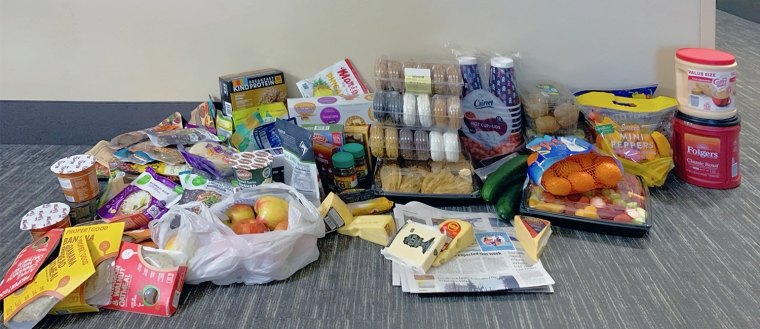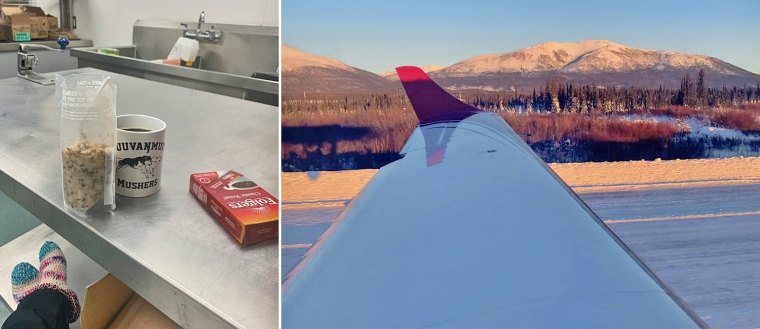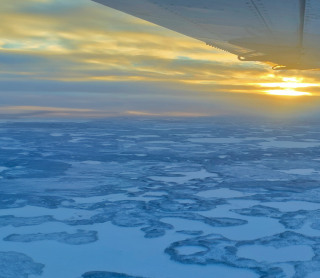“We got stuck in one of the towns for a few nights due to weather conditions, so we spent our days in the Tribal office with members of the community. And while it obviously wasn’t a part of the formal comment period, it was a huge opportunity to understand the perspectives of the people living there,” said Sarah Lupis, stakeholder engagement specialist and project manager at SWCA.
Lupis is referring to a recent trip she took to three rural Alaskan communities this winter to conduct public meetings and receive community feedback as a part of the National Environmental Policy Act (NEPA) and Alaska National Interest Lands Conservation Act (ANILCA) processes for a proposed infrastructure project.
With an average population of approx. 200 residents in each town located in remote parts of Alaska, these communities are close-knit. There are no roads, so transport to and from these communities is by charter plane or snowmobile. A subsistence lifestyle is core to the culture of these Alaska Native communities, referring to the harvest, use, and sharing of wild, renewable plant and animal resources for food, shelter, fuel, clothing, tools, or transportation as part of long-standing practices.1
With one backpack in tow, Lupis traveled with a small team of colleagues and partners for 10 days to provide meaningful opportunities for the public to participate and share their perspectives on the proposed project.
“Our role with community engagement for the NEPA and ANILCA processes is to really create spaces where everyone can show up and do their best. The agency can focus on listening and engaging with the residents and residents can feel as comfortable as possible to share their hopes and concerns,” Lupis remarked.
The SWCA team and their local partners coordinated all the logistics — travel, sleeping arrangements, meals, communications to the community, and public meeting details, including ensuring elders had a chance to speak first — all typical activities for a seasoned stakeholder engagement specialist like Lupis. Despite the added complexity from the weather and transportation challenges, what truly stood out was the profound impact of these efforts on the people involved.
“It was really moving to witness the passion that people have and how everyone wants the best for their community,” Lupis reflected. “It was memorable to see how people showed up — to listen and to be heard.”
Scroll down to see more first-hand details of Lupis’ and the team’s experience. Overall, SWCA visited 12 communities this past winter as a part of the comprehensive NEPA and ANILCA support provided on this project. Learn more about SWCA’s stakeholder engagement and NEPA expertise, and our work with Tribal nations.
1: Alaska Subsistence Program, Indian Affairs, U.S. Department of the Interior
Preparing in Fairbanks, Alaska. Everything that we purchased for about a week’s worth of food, not only for ourselves, but also items to contribute to the communities where we visited. We brought items that the community does not have regular access to, like doughnuts, summer sausage, cheese, and crackers. These communities are living subsistence lifestyles where they are hunting, fishing, growing, and harvesting their own food. All other items must be flown in by charter planes — a luxury that does not often happen.
 A week’s worth of food including doughnuts, summer sausage, cheese, and crackers.
A week’s worth of food including doughnuts, summer sausage, cheese, and crackers.
Transportation was one of the most challenging aspects of coordinating logistics. We took small charter planes to reach these remote communities and once there, we used a variety of transportation methods once in the communities to get around, including trucks, four-wheelers, and snowmobiles dragging sleds.
 Examples of the charter planes and snowmobiles used for transportation.
Examples of the charter planes and snowmobiles used for transportation.
Our first stop: Allakaket, Alaska. Basketball is a big deal in Alaska. The communities we visited had nice schools, which is generally where we slept, and they had pick-up games for kids and adults alike who showed up for open gym in the evening. So, we’d hang out at the school in the evenings, watching basketball, and then sleep there on the gymnasium floor.
 Kids playing pick-up basketball at Allakaket school gymnasium.
Kids playing pick-up basketball at Allakaket school gymnasium.
While stuck in Allakaket, Alaska, due to the winter weather conditions, we spent a great deal of time in the Tribal Administrator’s office. They always had coffee going, and they were cooking and feeding us and members of the community. One of the meals they made was caribou and it was delicious.
 Pictured on the left: Elisa Bergman, Tribal Administrator for the community of Allakaket, and Sarah Lupis of SWCA.
Pictured on the left: Elisa Bergman, Tribal Administrator for the community of Allakaket, and Sarah Lupis of SWCA.
We traveled with a small team of colleagues and partners, including people from the federal agency, our subcontractors, and a court reporter, and we even met Ricko DeWilde from NatGeo’s Life Below Zero series.
 Pictured on the left: team and community members in front of the Tribal Administrator’s office. Pictured on the right: Julie Aaronson, who joined for the first community visit, and Sarah Lupis of SWCA.
Pictured on the left: team and community members in front of the Tribal Administrator’s office. Pictured on the right: Julie Aaronson, who joined for the first community visit, and Sarah Lupis of SWCA.
Our second stop: Shungnak, Alaska. Next, we flew directly to Shungnak and arrived just in time to see a traditional way of life demonstration. We held the public meeting in the same space later that day.
 Sarah Lupis traveling via snowmobile and sled to the local school where the public involvement meeting was held later that day.
Sarah Lupis traveling via snowmobile and sled to the local school where the public involvement meeting was held later that day.
Our third and final stop: Kobuk, Alaska. After a brief stop in Fairbanks for the weekend to restock, we headed to Kobuk. Once we arrived in Kobuk, we made an announcement over the communitywide public address (PA) system to remind residents of the upcoming public meeting.
 Photos of the time spent in Kobuk, Alaska.
Photos of the time spent in Kobuk, Alaska.
In each of the three communities, we held public involvement meetings in the evening and then on the next morning, our subcontractor and the federal agency led open listening circles to gather more information about subsistence resource use.
 Public involvement meetings held in the gym and a classroom of the local school.
Public involvement meetings held in the gym and a classroom of the local school.
An early morning breakfast in Kobuk before the listening circle; then it was time to start heading back to the Lower 48. Farewell, Alaska! Until next time.
 Early morning breakfast before taking the first of a few flights to get back to the Lower 48.
Early morning breakfast before taking the first of a few flights to get back to the Lower 48. 